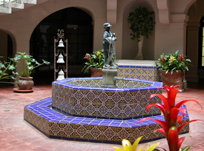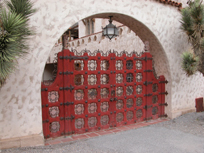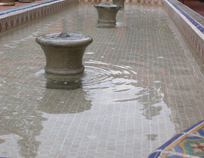Spanish Accents

 In the first entry in this series of articles, we opened a discussion of the hurdles watershapers encounter when attempting to integrate pools or spas with architectural styles that historically never had swimming pools associated with them. (See the Feb. 8 edition of WaterShapes EXTRA!)
In the first entry in this series of articles, we opened a discussion of the hurdles watershapers encounter when attempting to integrate pools or spas with architectural styles that historically never had swimming pools associated with them. (See the Feb. 8 edition of WaterShapes EXTRA!)
Let’s start our first detailed discussion with a major example of this phenomenon by looking at the facets of Spanish Colonial Revival as an architectural form and speculating on what it takes to make things work when a watershape is added to the picture.
Ancient Roots
What we know as the Spanish Colonial Revival style has its origins in the Moorish architecture that swept from Persia and across the Middle East and North Africa before influencing Europe more than 1,300 years ago.
In fact, the Moors occupied much of what is now Spain from the 8th century until the early 14th century, bringing with them architectural forms that took root and have been part of the vocabulary of Spanish style ever since. Imperial Spain exported these tastes to the New World, first in South and Central America then in what are now the Southwestern United States. In Southern California in particular, this style expressed itself in first part of the 20th century as a “revival.”
 This modernization of an ancient design style incorprated four major materials – plaster, terra cotta, iron and wood – along with accents made up of decorative, hand-painted tile. These four and a half elements can be found in almost every single Spanish Colonial Revival project.
This modernization of an ancient design style incorprated four major materials – plaster, terra cotta, iron and wood – along with accents made up of decorative, hand-painted tile. These four and a half elements can be found in almost every single Spanish Colonial Revival project.
The plaster (typically white) serves as a neutral background in these projects, setting off the terra cotta pavements and curved roofing tiles. Apertures such as doors and windows were typically adorned with black iron hardware and thick, rough-hewn wood. Then the entire space was adorned with ribbons of colorful tile as step risers or veneers in or on fountains.
Making It Work
In designing modern watershapes to fit within these surroundings, you need to think in the context of the style’s key materials. Simple, neutral plaster colors set against the rich, brownish reds of terra cotta pavers or copings and contrasting with thick, dark wood doors, shutters and furnishings with iron hinges all help – particularly when they’re tastefully accented by beautifully colored, hand-painted tiles at the waterline and across other special areas.
But it’s not all about mirroring materials: The shape of the water is important, too, in its role in the setting’s formal, axial geometry. Most of these spaces are set up as quadrants, and watershapes must fit into the scene. This most often means long and linear shapes fitted to the grid – although square, octagonal, quatrefoil or circular shapes work as well so long as these elements are centrally placed or are used to anchor a linear axis.
 In fact, just about any defined geometric shape will work – meaning you can only go truly wrong in a conventional Spanish Colonia Revival space by going with a freeform watershape.
In fact, just about any defined geometric shape will work – meaning you can only go truly wrong in a conventional Spanish Colonia Revival space by going with a freeform watershape.
But let me offer a caution here that will apply to everything I’ll cover in this series: In an environment where there are few precedents, we as designers have great liberty to choose our own paths. Where my observations might guide me to formal geometry in a Spanish Colonial Revival setting, that doesn’t mean something else won’t work. The key is being aware of the vocabulary you have to work with and making sensible choices among the many options you face, particularly if trailblazing is on your mind.
Next: A look at the Early American Colonial Revival.
.
Mark Holden is a landscape architect, pool contractor and teacher who owns and operates Holdenwater, a design/build/consulting firm based in Fullerton, Calif. He may be reached via e-mail at [email protected].









